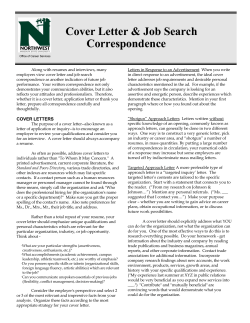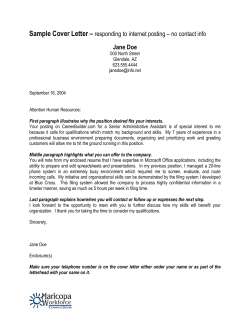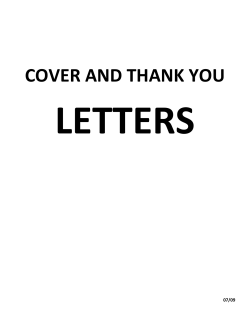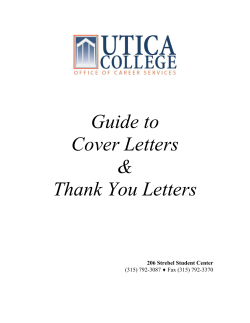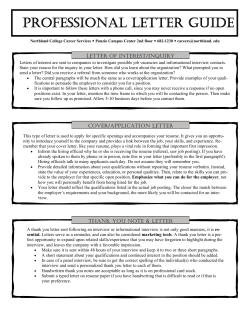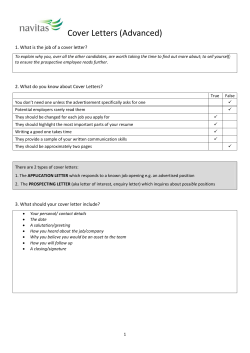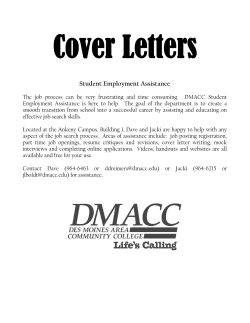
How to Get that Job! How to Write Successful Applications…
How to Get that Job! How to Write Successful Applications… Components of an application Generally your application will comprise three major components; • • • A cover letter An up-to-date version of your resume Your response to the key selection criteria Usually public institutions (including most of the larger Australasian Zoos) will require that you submit all three of these components as your application, however smaller institutions and many private Zoos may only require a cover letter and CV or Resume to be submitted. Some larger institutions may also require that you complete a specific “application form” which must also be submitted. Requirements for applying will usually be included in the advertisement or specify where this information can be obtained. Supporting documentation such as copies of educational qualifications may also be required. Usually you are also required to provide referees that can be contacted by the selection panel to verify your experiences. In some organisations that require your applications to be posted to them, multiple copies of your application may also be required. Structure of the application documents. Layout: Where appropriate, dot points should be used rather than using long paragraphs of text. This ensures that the statement is as easy as possible for the selection team to read (and also demonstrates written communication skills in the document itself). Length: With both the CV and address to the selection criteria, being concise is important. Make sure that your CV covers your entire work history and highlights any aspects which are relevant to the position you are applying for. For your response to the selection criteria, about 250 words (approximately ½ to ¾ of a page) is generally an appropriate length for each selection criterion, however this may depend upon factors such as the role being applied for. Downloaded from http://www.australasianzookeeping.org Presentation: You should ensure that: • • • There are no spelling errors anywhere in the documents; The documents are formatted neatly; and The sentences are grammatically correct and precise. It is important that your application is easily readable to the selection panel and hand written applications should be avoided wherever possible, particularly when applying for a position with a larger institution. The cover letter. Whilst a cover letter is usually not a compulsory part of an application, they are generally a good way of introducing yourself and providing key contact details such as postal address, contact phone numbers etc. A cover letter also allows you to provide a more “personalised” introduction of yourself to the selection panel compared to the more rigidly structured CV and response to selection criteria. You should begin the covering letter stating what position you are applying for and where you saw the position advertised, and then providing a very brief overview of your work experience and qualifications. At the end of the cover letter you should also make a brief statement about what strengths you believe you would bring to the position. It is important that the cover letter be kept very brief – usually no more than ¾ to 1 ½ pages is sufficient. The resume or CV. The resume (sometimes called a curriculum vitae or “CV”) basically outlines your past roles, responsibilities and qualifications as they relate to the position you are applying for. These can be examples from past work roles, involvement with the community and voluntary roles and should be presented in a “dot point” or “bullet” form. It is important that your resume presents your personal information, contact details, education and work background in a clear and structured way. This will not only make it easier for the interview panel to identify and contact you, but also make it easier for the panel to see how your capabilities, personal qualities and background fit the job. Also include at least two referees and their contact details. You can download a PDF sample resume from the AZK web site by going to Downloaded from http://www.australasianzookeeping.org http://www.australasianzookeeping.org/PDF%20&%20Word%20docs/Exa mple%20CV.pdf to give you an idea of how to start. You can also go to your local library or search the internet for other examples or templates that you may prefer to use. Understanding Job Descriptions and Key Selection Criteria. Job descriptions: If you don't fully understand the job requirements you may have difficulty demonstrating that you are the best person for the job. Study the Position (or job) Description, along with any other relevant information provided about the job. If you are unsure about any aspects of the position, get in touch with the contact officer (the name and contact details will usually be specified in the job advertisement) during normal business hours. Generally the job description will outline areas such as; • Values: These tell you about the way the organisation works and what it expects of its employees. Check that you are comfortable these values fit with the way you want to work. • Accountabilities/responsibilities/duties: This is a broad outline of the function and role of the position and may list the day-to-day responsibilities and tasks of the job. Each job has a key focus - for example some roles supervise staff, some manage resources or provide technical advice and others may deliver support services. Your career background and aspirations should match the requirements of the job. You will need to be able to demonstrate that you have the personal qualities, knowledge and skills to do the job. • Special conditions: Details of whether weekend work, out of hours work or other conditions will be expected of the position will also be outlined in the job description. Selection Criteria: Where Selection Criteria are specified for a position (they are commonly used by larger organisations), it is critical that these are addressed as a part of your application. This is the most common fault I have seen in the thousands of applications I have reviewed over the years, and often results in applications from people that may have been ideally suited to the position being rejected by the selection panel. Applicants are short-listed based on Downloaded from http://www.australasianzookeeping.org their ability to convince the Selection Team that they have the ability and skills to perform the roles and responsibilities that are articulated in the selection criteria. Selection criteria describe the personal qualities, experience, skills, abilities, knowledge and qualifications (if any) a person needs to perform the job effectively. They set out the standards by which each candidate will be assessed and are used by the selection panel to identify the right person for the position. Selection criteria vary among employers and jobs. Traditionally, they are statements combining skills, knowledge, experience and personal qualities. Selection criteria are used in an effort to even up the playing field by providing a common set of factors against which the selection panel can assess candidates. It makes the process fairer for everyone. Selection criteria for most positions are quite broad or generic, making it possible to compare people with different backgrounds and experience. Resumes are usually not sufficiently detailed to enable the selection panel to evaluate experience and achievements fully. Selection criteria also provide an objective basis on which to base selection decisions. Because of the nature of the public sector and many larger organisations, the selection process must withstand independent scrutiny and may be an issue of public accountability. The intention of selection criteria is to provide everyone with a level of assurance that each job is filled by a person who has the requisite skills, experience and attributes. The selection panel will rate all of the applications received against the criteria in order to select the best applicant for the job. Selection criteria are generally divided into two sections: • • Essential (or important) criteria Desirable (or less important) criteria Essential criteria are often viewed as being critical to an applicant being able to undertake the role and you may not be short listed for an interview unless you can demonstrate that you possess these attributes. If a criterion is essential it generally means that it is not possible to do the job properly unless you meet that criterion. If there is no candidate who meets all of the selection criteria to a sufficient extent, often no one is selected and the job will be readvertised. Desirable criteria have a lower weighting than the essential criteria, and whilst it is not necessary for you to have the qualifications, skills and knowledge outlined as “desirable criteria”, your chances of progressing through the selection process (and being short-listed) will be greater if you Downloaded from http://www.australasianzookeeping.org meet all the selection criteria, as you may be competing against many applicants. Addressing the Key Selection Criteria/Person Specification. Generally I have found that the following process helps in the development of a response to the selection criteria. Preparation: 1. Copy and paste the selection criteria into a new Word document. Make them bold and make sure that they are in the same order as they are found in the original Selection Criteria document. 2. Create a space between each criterion to insert your response. 3. Examine your resume and extract all of the experience, skills, achievements, qualifications and abilities from each job that relate to each criterion. Copy and paste your experience, achievements, qualifications and so forth into the space under each criterion. You now have the core data needed to begin composing your response to the criteria. Composing your Response: An effective response should: • • • • Explain the nature and extent of your experience Outline your responsibilities Show your accomplishments Provide concrete examples The key is to: • • • Demonstrate capability by providing evidence of how you meet the selection criteria; Provide specific details; and Where possible, include an indicator of success or a result. An easy way to do this is to use the STAR model: Situation – provide a brief outline of the situation or setting Task – outline what you did Approach or action – outline how you did it Result – describe the outcomes. Downloaded from http://www.australasianzookeeping.org Examples are an easy way to demonstrate that you meet the requirements of a position. For example, if a job requires a person to have the ability to supervise staff, provide the reader with two or more examples of successful supervision situations in which you have played a significant role. Describe the context, your goal, your strategy, the reason or rationale for the strategy and the outcome of the situation. Draw particular attention to any noteworthy achievements by using the “STAR” model. An effective response to selection criteria provides the members of the selection panel with clear evidence that you meet the requirements of the position. Presenting beliefs, philosophy or knowledge is not evidence of your abilities or experience. For example, don’t write a thesis on leadership - use examples of your experience and achievements as a leader. Telling the reader what you know about leadership doesn’t demonstrate experience or achievement. To simply state that you have five years experience as a Keeper and you must therefore be a good one is not a sufficient response to a criterion about your Keeping abilities. Providing a vague, loose and generalised comment is also not enough. The selection panel wants to know what you have actually done and you need to consider the environment in which the position operates in order to make your own responses relevant. Criteria dealing with your commitment to an ethos or code of conduct are quite common amongst larger organisations. A position might require, for example, “Knowledge of and demonstrated commitment to Equal Employment Opportunity and Occupational Health and Safety”. But how do you demonstrate commitment in writing? Many people simply resort to asserting that they are committed, however to successfully respond to a criterion relating to ethical issues you need to demonstrate that you have operated under these principles. Give concrete examples of situations where you instigated, implemented or upheld these principles. Follow the four steps outlined below to help you gain the edge you need to get the interview and secure the position. Step 1 – Understanding the selection criteria: As an example, take the capability of written communication skills. The associated selection criterion could be: “Well developed written communication skills. This includes the ability to: • Structure written communications such as reports to meet the needs and understanding of the intended audience; • Express opinions, information and key points of an argument clearly and concisely; and to • Write convincingly in an engaging and expressive manner.” Downloaded from http://www.australasianzookeeping.org Highlight key words in the selection criteria and think about what the employer is asking for. It is important that you clearly understand what is meant by each selection criterion before putting pen to paper. Step 2 – Opening sentence: When addressing each selection criterion, you should begin with an opening sentence that clearly states your claim to this criterion. For example: “I possess strong written communication skills, which I have developed over the course of my career.” This opening statement needs to be supported by detailed examples of where you demonstrated these skills in the workplace (or other context if workplace examples are not possible). The following steps will help you to provide a structured, easy-to-understand response. Step 3 – Brainstorm ideas for each criterion: For each selection criterion, brainstorm ideas from your recent work life. Where you do not have relevant work examples, situations from different aspects of your life (e.g. university, clubs or the community) may also demonstrate relevant strengths. For instance, acting as the secretary for a large club may be an appropriate example for the selection criterion described above. Let’s take an example of a Senior Keeper role, which includes “well developed written communication skills” as one of the selection criteria. An applicant may come up with the following situations that could be used to illustrate their written communication skills: • Bird Keeper at XYZ Zoo – wrote a paper on breeding Wrens for industry journal • When employed at ABC Zoo – designed and compiled a monthly staff newsletter • Research project when at GBL Zoo – needed to collate diverse sets of breeding data, organise the information, and submit report to senior management. At this stage, it is useful to generate as many examples as possible. Step 4 – Expand on your brainstorming ideas – provide the evidence: You should then expand upon the points that you have gathered as part of the brainstorming activity in step three. Go back to each specific criterion and make your final choice on which examples to use, by matching them against the wording of the criterion. Once you have finalised your examples, you need to demonstrate how they meet the different aspects of the criterion. In doing so, it is important that you are very specific and describe exactly what you did, including the outcome. Downloaded from http://www.australasianzookeeping.org This is to demonstrate convincingly that you have met the requirements of each criterion. Use the “STAR” method described earlier. For example: • Situation – When employed at ABC Zoo • Task – Needed to ensure that all staff were kept informed of recent and upcoming events across the Zoo • Action or approach – Initiated monthly newsletter, which was distributed to all staff. Took responsibility for writing the main articles. This involved obtaining ideas and input from other staff to ensure that the articles reflected all sections of the Zoo. • Result – Feedback was consistently excellent. Received annual staff recognition award for newsletter quality. Led to improved lines of communication across all work sections and amongst all staff. You can then write the draft paragraph in full. For example: “When employed at ABC Zoo, I needed to ensure that all staff were kept informed of recent and upcoming events across the Zoo. To do this, I initiated a monthly newsletter, which was distributed to all staff. I took responsibility for writing the main articles in each publication, which involved obtaining ideas and input from other staff to ensure that the articles reflected all sections of the Zoo. I received consistently excellent feedback in relation to the newsletter and was awarded an annual staff recognition award for the quality of this newsletter from management. Importantly, this initiative resulted in improved lines of communication across all work sections and amongst all staff.” Step 5 – Checking your work At this stage, you should read through your application, and check the following points: • Have I used positive and specific language? It is important that you avoid ambiguous or unclear expressions such as “involved in” or “assisted”. These expressions make it difficult for the reader to understand exactly what you did. For example, instead of “I assisted the process through a monthly newsletter”, use the phrase “I initiated a monthly newsletter”. Words and phrases that could reduce credibility should also be avoided (e.g. some, a little, limited, somewhat). • Have I used strong action (doing) words? Avoid using passive language when describing your experience. For example, “I received consistently excellent feedback in relation to this newsletter from these internal clients and my own manager”, is better than simply stating, “Feedback in relation to this newsletter was Downloaded from http://www.australasianzookeeping.org consistently excellent”. • Have I avoided unsupported claims about my capabilities? For example, rather than simply saying, “The newsletter was received well by others”, this assertion is substantiated by: “…and was awarded an annual staff recognition award for the quality of this newsletter from management.” • Have I addressed all aspects of the criterion? At this stage, it is important that you go back to the wording of the particular selection criterion. As mentioned earlier, “Well developed written communication skills” includes the following components: - Structure written communications such as reports to meet the needs and understanding of the intended audience; - Express opinions, information and key points of an argument clearly and concisely; and to - Write convincingly in an engaging and expressive manner. In reading the draft paragraph written out in “step 4”, it is clear that its content refers mainly to the first descriptor, that is, “Structure written communications to meet the needs and understanding of the intended audience”. Therefore, it will be important that you address the remaining two descriptors from “step 1” in additional paragraphs. This will then make up the complete statement for the criterion “well developed written communication skills”. • Have I paid attention to the language of the criterion? For example, writing a paragraph around an example that demonstrates “Well developed written communication skills” requires the applicant to focus on actual experiences that show the extent of their skills in this area. However, if the criterion was phrased as “Knowledge of effective written communication skills and techniques”, this would require different examples that do not necessarily rely on the applicant describing their actual performance in the workplace. The final steps. Once you have gone through the above steps for all of the selection criteria you are ready for the last few details. Talk to the referees you have selected about the job you are applying for and what they will say about you to a prospective employer. Make sure that you supply the contact details for the number of referees specified in the Downloaded from http://www.australasianzookeeping.org application pack, and that their ability to speak of your abilities is relevant to the position you are applying for. Finally, have someone check over your complete application (cover letter, CV and response to the selection criteria). Ask them to read for clarity of expression, correct grammar and spelling as well as how adequately the response addresses the selection criteria. Make any changes required and add any supporting documentation (such as copies of mandatory qualifications etc). In some positions formal qualifications are either not required or are an added advantage (desirable), however most roles today need some form of formal qualifications, such as a Zoo Keeping certificate, driver’s license or University Degree. If there are formal qualifications or licences specified in the job advertisement, you must be able to produce copies of these qualifications to be appointed to the job. You may also be required to complete a specific application form or supply other information about criminal convictions, your preferred hours of work or willingness to attend a medical fitness examination (for example). Make sure you respond to these questions in your application. Congratulations! You are now ready to submit your application. How do I submit an application? There are a number of ways in which applications may be submitted, including an “on-line” application at a specified web site, by e-mail or by posting your application through the mail. The job advertisement will usually state how applications will be accepted, however if you are not sure then get in touch with the contact person specified in the job advertisement to see what methods are acceptable. It is important to ensure that your application is received by the closing date (and time) specified in the job advertisement. Many institutions (particularly larger ones) will not accept your application if they receive it after the closing date. If you experience difficulties in getting your application submitted in time, get in touch with the contact person specified in the job advertisement to see if you can be granted an extension to the closing time. Acknowledgement of applications: Some organisations will acknowledge that they have received your application by post or e-mail, however this will vary between institutions and the type and level of the position being applied for. If the advertisement does not state whether you will receive acknowledgement, contact person specified in the job advertisement to check. Downloaded from http://www.australasianzookeeping.org If you submit your application via the web or by e-mail, it is a good idea to check that the application has been received and that all your attachments came through OK – there is nothing worse than going to all of this work getting a great application together and then finding out after the closing date that it got lost in cyberspace! Downloaded from http://www.australasianzookeeping.org
© Copyright 2025



